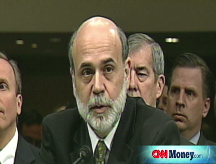Looser lending as confidence rises
Stocks rise around the globe as investor sentiment rebounds. Loan rates fall and Treasurys sink ahead of $34 billion auction.
NEW YORK (CNNMoney.com) -- Following a rebound in investor sentiment and global stocks, U.S. Treasury prices and bank-to-bank lending rates both fell Tuesday.
Fears about the impact of the credit crisis on the global economy subsided at least for a day, as financial institutions and investors cheered recent efforts by global central banks to stimulate lending. Central banks have lowered interest rates and directly injected capital into the banking system.
The overnight Libor rate fell for the second-straight day to 1.24% from 1.26% on Monday, according to Dow Jones. The 3-month Libor rate nudged lower to 3.47% from 3.51% on Monday, according to Dow Jones.
Lending rates have been trending downward for nearly two weeks. Libor is a daily average of what 16 different banks charge other banks to lend money in London.
As rates fell, two key indicators of risk sentiment showed that confidence in the market was rebounding.
The "TED spread" fell to 2.61 percentage points before recovering slightly to 2.70 from 2.76 points Monday. The TED spread measures the difference between the 3-month Libor and the 3-month Treasury bill, and is a key indicator of risk. The lower the spread, the more willing investors are to take risks.
Another indicator, the Libor-OIS spread, eased to 2.61 percentage points from 2.63 points Monday. The spread measures how much cash is available for lending between banks, and is used for determining lending rates. The bigger the spread, the less cash is available for lending.
With lending becoming cheaper, encouraging news came from the Bank of England and the Swiss National Bank. The central banks offered a combined $20 billion in liquidity to financial institutions Tuesday, but only received bids for less than half of that amount. Fewer bids could mean that banks are again able to gain access to funds through traditional lending methods.
"The money was intended to be a backstop to institutions that need dollar financing, so the lack of bids suggests that the necessity of those funds is diminishing," said Pierre Ellis, senior economist at Decision Economics.
Confidence in the credit markets improved as governments have stepped in to help restore liquidity. Through one such method, the Federal Reserve's Commercial Paper Funding Facility, the U.S. government began to buy up large amounts of company debt in an attempt to ease short-term financing concerns. General Electric Co. (GE, Fortune 500) said it sold less than $5 billion to the government Monday, according to the Financial Times.
A spokesman from GE would not confirm the exact amount, but said that the FT article allowed for "a generous range." He said the Fed's initiative is helping to restore liquidity to this vital sector of the credit market.
"Having this facility certainly restores a level of confidence in the market," said GE spokesman Russell Wilkerson. "The new liquidity should help foster lending and borrowing with longer maturities, which will help the market overall."
Investors are betting that even more intervention may be on its way in the form of rate cuts. According to the Chicago Board of Trade, investors now believe there is an 100% chance that the Federal Reserve will cut its key funds rate by as much as a half of a percentage point to 1% in an attempt to stimulate the economy when it completes its two-day meeting that begins Tuesday.
"If investors see that the Fed is doing a lot of things to stabilize the situation, they'll be less worried about lending," said Pierre Ellis, senior economist at Decision Economics. "But the problem will be solved very, very gradually; there is no miracle cure."
Government debt was much lower Tuesday as global stocks reversed their recent downward trend and a late day rally on Wall Street sent the Dow surging 889 points. Anticipation of the enormous $34 billion auction of 2-year notes also sent Treasurys falling.
The benchmark 10-year note fell 1-12/32 to 101-5/32, and its yield rose to 3.86% from 3.68% late Monday. Bond prices and yields move in opposite directions.
The 30-year bond sank 2-27/32 to 105, and its yield was 4.21%, up from 4.05%.
In order to finance its $750 billion financial rescue plan, the Treasury is set to auction off $34 billion in 2-year notes Tuesday. Investors sold off short-term debt before the huge amount of supply comes into the market.
With an influx of billions of dollars of fresh, short-term government debt to be auctioned this week, as well as a possible rate cut Wednesday, shorter-term debt was lower. Rate cuts tend to be inflationary, and bond investors worry that their assets will devalue over time as the dollar sinks.
The 2-year note fell 2/32 to 100-26/32, and its yield rose to 1.58% from 1.53% late Monday.
With market anxiety subsiding for a day, the yield on the 3-month bill rose to 0.77% from 0.75% on Monday.
The yield on the 3-month Treasury bill is closely watched as an immediate reading on investor confidence. Investors and money-market funds shuffle money into and out of the 3-month bill frequently, as they assess risk in the rest of the marketplace. A higher yield indicates that investors are slightly more optimistic. ![]()




